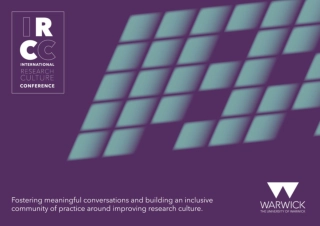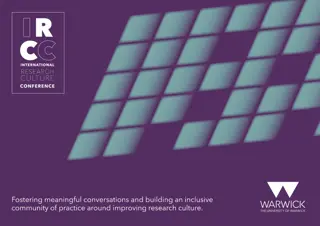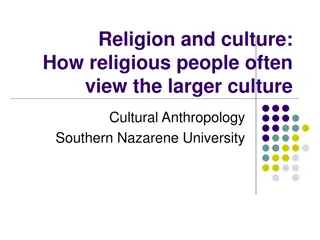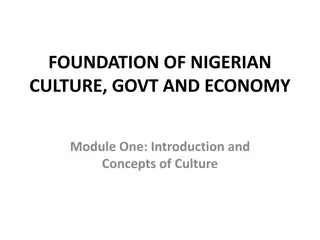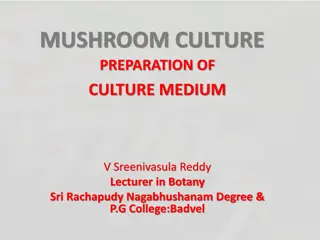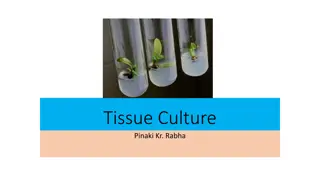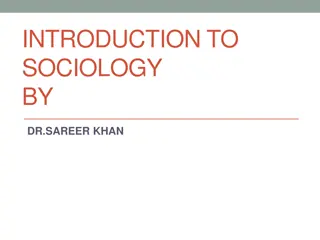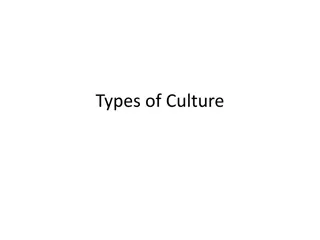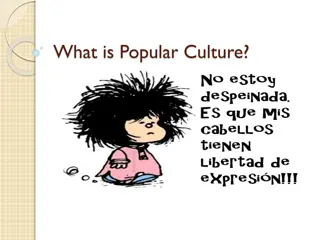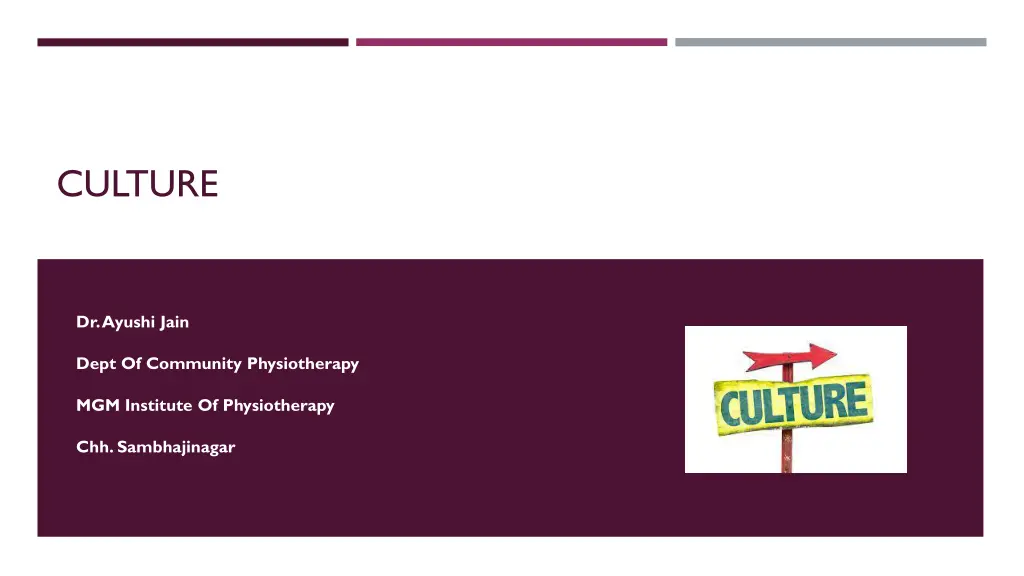
Understanding Culture: A Comprehensive Overview
Explore the concept of culture through its definition, characteristics, types, functions, and organization. Discover how culture shapes society, influences behavior, and impacts individual and group lives. Gain insights into the dynamic and evolving nature of culture, its transmission, and societal implications.
Uploaded on | 2 Views
Download Presentation

Please find below an Image/Link to download the presentation.
The content on the website is provided AS IS for your information and personal use only. It may not be sold, licensed, or shared on other websites without obtaining consent from the author. If you encounter any issues during the download, it is possible that the publisher has removed the file from their server.
You are allowed to download the files provided on this website for personal or commercial use, subject to the condition that they are used lawfully. All files are the property of their respective owners.
The content on the website is provided AS IS for your information and personal use only. It may not be sold, licensed, or shared on other websites without obtaining consent from the author.
E N D
Presentation Transcript
CULTURE Dr. Ayushi Jain Dept Of Community Physiotherapy MGM Institute Of Physiotherapy Chh. Sambhajinagar
INTRODUCTION Culture is derived from the English word kulthra and Sanskrit word samskar , which denotes social channel and intellectual excellence. Culture is a way of life. Culture is an organisation of phenomenon of acts (patterns of behaviour) objects (tools) ideas (belief, knowledge, sentiments) attitudes values the use of symbols.
DEFINITION Culture is a complex whole, which includes knowledge, belief, art, morals, customs and any other capabilities and habits acquired by the man as a member of society EB Taylor
CHARACTERISTICS Culture is an acquired quality or learned way of behaviour. It is learned through experience, imitation, communication, concept, thinking and socialisation process. Culture is transmitted by vertically or horizontally and thus it is communicative. Vertical transmission is from generation to generation, horizontal transmission is from one group to another group within the same period. Culture is social but not individual. Culture is idealistic, adoptive, integrative. Culture fulfills some needs and desires of individual to fulfill group functions.
Culture evolves into more complex forms through division of labour, which develops special skills, the interdependence of members within the society. Culture is continuous and cumulative. Culture is dynamic. Culture is subjected to slow but constant changes. Culture is gratifying. Culture provides opportunities and provides means for the satisfaction of our needs (biological and social) and desires. Culture varies from society to society. Culture is super organic. Culture is independent of physical and physiological properties and characteristics.
TYPES OF CULTURE Non- material culture Material culture
FUNCTIONS OF CULTURE 1. Culture makes man as a social being. 2. To regulate the conduct and prepares the human being for group life through the process of socialisation. 3. It defines the meaning of situation. 4. Provides solutions to complicated situations as it provides traditional interpretation to certain situations. 5. Defines values, attitudes and goals. 6. Broaden the vision of individuals. 7. Provides behaviour pattern and relationship with others. 8. Keeps the individual behaviour intact. 9. Creates new needs and interests. 10. Moulds national character. 11. Defines myths, legends, supernatural believes
ORGANISATION OF CULTURE Cultural trait Cultural pattern Folk ways Cultural area Norms laws mores
FACTORS OF CULTURAL VARIATIONS Historical accidents. Eg: Monogamy, Polygamy. Geographical environment. Mobility of human beings. Inventions, Discoveries which influence technology, customs, traditions, believes and faith. Individual peculiarities. Change on modes of production. Dominant cultural themes.
COMPONENTS OF CULTURE symbols sanctions language laws values belief norms mores folkways
IMPACT OF CULTURE ON HUMAN BEHAVIOUR Human behaviour change from moment to moment, according to the situations. As the culture is the product of human interaction, the human being will be defined and identified by the culture. They will share the values, believes, material objects, ideas, feelings, knowledge, which will transmit from one to another as a social product. Human behaviour is entirely the product of social learning
The impact of culture over the human behaviour will have both positive and negative effects. Some of the positive effects like: Respect each other, love the neighbourhood Love all, hurt never Share the ideas, thoughts, feelings, and responsibilities with loved ones. Some of the negative effects: Untouchability Superiority and inferiority feelings Devadasi system.
CULTURE INDUCED SYMPTOMS AND DISEASES Culture, is the way of living in which the customs, traditions, practices, attitudes, ideas, knowledge will influence individual s life style. Among these food habits also plays a major role, as a part of culture of a community. Eg: Andhra people consume more spicy food, which may predispose for gastritis. Certain community will consume only pure vegetarian food in which they will avoid even onion and garlic, thus leading to nutrition imbalance. Subsequently these people are prone for gastric diseases. Other religious consume more of non-vegetarian food, which may lead to obesity, hypertension, and cardiac diseases. Pardah system by the women followed by certain community will predispose for vitamin-D deficiency. In urban community, due to mechanisation, industrialisation people s life become monotonous and stress to adjust and accommodate themselves to the changing demands etc., prone for mental illness.
CULTURAL FACTORS AFFECTING HEALTH AND DISEASES Customs Eg: If age at marriage and age-at gauna is low, may predispose to early pregnancy and will affect mother and child Widow remarriages may cause frustration, conflicts and unsoundness in the family Polygamy, polygynae, devadasi system, dowry system, alcoholism, drug abuse, will influence the individual s health
CULTURAL FACTORS AFFECTING HEALTH AND DISEASES Beliefs Certain religious community does not take any form of medicine or does not utilize the health services as they believe the diseases are due to anger of God, or punishment for their sinful activities, for relief of the illness they will perform pooja, offering prayers, and follow some vaastu principles, due to these believes their health is deteriorating. Communicable diseases like mumps, measles, chicken pox are occurring due to the curse of the Goddess and the community will visit temples for the cure of the disease, instead of going to health care members. Some cultural factors are positive in nature. If an individual is affected with chickenpox certain practices will be followed like hygienic principles, such as cleanliness, isolation, barrier techniques, giving bath with neem leaves dipped in hot water, giving bland diet for the affected children.
CULTURAL FACTORS AFFECTING HEALTH AND DISEASES The coitus during menstrual periods will result in the prevalence of sexual disorders. Hysteria is the result of possession of evil spirit. During menstruation certain family will not allow the person to do the family activities and given rest. Some elders will not permit the post-natal mother to give colostrum, which is essential for the specific protection for the new born. Food restrictions such as eating papaya during first trimester, as it may induce abortion. During fairs and festivals, certain practices like, whitewashing the house and all the family members will gather together, share their joys, problems, which will promote the soundness in the family. Performing pranayama, meditation and yoga techniques will induce sound mental health.

